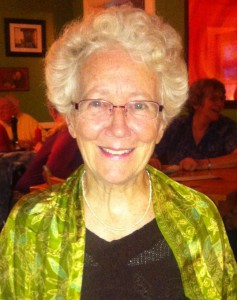Friday
Community ArticlesAging and Sensory Loss
article by Pam Dreiling
Over the last couple of years I have noticed more difficulty remembering and retaining continuity of thoughts and ideas, a common result of aging. I have also noticed changes in my sensory experiences: hearing, vision, taste, smell, touch.
Our senses connect us to the world, to each other. As we age our senses begin to decline. In sensory experience there is a minimum level of stimulation (called threshold) that is required to become aware of a sensation. Aging increases this threshold. We begin to lose our sensory connectedness. These sensory losses affect our lives in many ways. They can contribute to social withdrawal, isolation, paranoia, anxiety and depression. How will we manage these changes, losses as Shambhalians?
Vision: All the eye structures change with aging. The corneas become less sensitive; pupils decrease in size and react more slowly in response to darkness and bright light. The lens becomes less flexible and slightly cloudy. Eyes sink into sockets as fat deposits decrease. Eye muscles weaken and our visual field decreases. Vitreous, the gel like substance in eyes, shrinks, creating particles called floaters. Sharpness of vision or visual acuity declines.
Presbyopia, difficulty focusing on something close, may necessitate reading or bifocal glasses. Less tolerance of glare and bright lights and reduced peripheral vision may limit activity and cause difficulty driving at night. Dry eyes can cause infection, inflammation and scarring of the cornea.
Common eye problems that may develop as we age are cataracts, glaucoma, macular degeneration and diabetic and hypertensive retinopathy.
Personally, when I am reading, the words are more difficult to focus on and blurry spots often occur. No cataracts yet, but that is almost a given as we age. I get tested yearly for glaucoma as my father was diagnosed with it and it is a genetic condition.
Taste and Smell: These senses work together. Most taste come from odors. There are 9,000 taste buds which decrease as we age, and each remaining taste bud loses mass or atrophies. Sensitivity to the four tastes often declines with salty and sweet tastes being lost first, followed by bitter and sour. Is this why elderly people often want more salt on their food or crave sweets? The mouth produces less saliva resulting in dry mouth and reduced taste. For many people there is a loss of appetite because food is not as appealing.
Sense of smell may diminish. This may be related to loss of nerve endings in the nose and to less mucus being produced in the nose. Mucus helps odors stay long enough to be detected by the nerve endings. It also helps clear odors from the nerve endings. Medications can greatly affect our sense of taste and smell.
For me food does not seem to taste as good as it used to. I find there are certain smells and tastes that I yearn for. Is this because taste and smell are so indelibly rooted in our inner brain and pre-conceptual years?
Touch, including balance, vibration and pain: With aging we may experience reduced or changed sensations. Decreased blood flow and nerve damage (peripheral neuropathy) can affect our ability to detect pain, hot and cold, pressure and vibrations, increasing our risk of burns, frostbite, hypothermia and pressure ulcers. Perceiving where our body is in relation to the ground may be reduced, resulting in problems with walking.
Our skin also thins as we age making us more sensitive to touch and vulnerable to injury. Elderly people often feel uncomfortably cold because of decreased circulation.
Hearing: Hearing is considered our “social sense”. It keeps us connected to others through the ability to communicate. Hearing loss can have a profound effect on our understanding of information and social interactions. Helen Keller, who was both deaf and blind, said that “Blindness separates people from things; deafness separates people from people.”
Presbycusis, or age related hearing loss is the 3rd leading chronic condition affecting adults over 75. Sensorineural hearing loss is progressive, bilateral, with a gradual onset. An associated symptom of hearing loss is tinnitus, a persistent, abnormal ear noise or ringing. Today, with almost constant exposure to sound levels above 85db (the threshold where permanent inner ear nerve damage occurs), hearing loss has become a fact of life.
My hearing loss is not solely age related as I first noticed it when I was 20. It has continued on a slow, steady decline over the last 45 years, and I am now labeled (and in fact) profoundly HoH or hard of hearing.
Declining hearing is rather insidious as it begins unnoticed, slowly, imperceptibly at first. The repercussions of missing a word here and there, then parts of a conversation, the punch line of jokes are cumulative. Humans have a repertoire of compensatory tactics to manage this. But hearing loss takes its toll. It is only recently dawning on me how significant an impact my hearing loss has had in my life. I have been severely affected in social interactions, relationships and learning. Group situations I avoid, as I cannot understand 98% of the conversations. I now even feel an intellectual loss from missing vital, basic information on a day to day basis. Hearing the teachings at the Shambhala Center or public gatherings is almost impossible.
Hearing aides are the main option available for people who are HoH. I am thankful every day for them as they enable me to continue to interact in the world. But they are not a panacea for all hearing losses; they do not help me in group situations. And they are expensive ranging from $1,500 – $4,000 per aide. For people who are almost completely deaf cochlear implants may be an option. An implant does not restore normal hearing. Instead, it can give a deaf person a useful representation of sounds in the environment and help him or her to understand speech.
Being able to hear clearly is becoming difficult for many people in the aging Shambhala community. The Halifax Shambhala steering committee on aging is looking into wireless headphones to enable HoH people to hear talks and presentations at the Center.
Mind: Specifically in this context I am thinking of dementia. This vast and intense change in a person’s mental state is beyond my ability to comment on here. I am hoping that more knowledgeable people in the Shambhala community will delve into this experience, especially as it pertains to Shambhala path and practice. Is this aging sensory loss and disconnecting to the world a preparatory process, like dress rehearsals, for our encounter with the dissolution of our senses upon death?
 It is not my intention to make aging sound grim. Aging is happening each moment from birth. At some point it is about giving up rather than getting. It usually involves greater needs. How will we manage these changes and losses? How can we help each other as more of us become elderly? Sharing information, ideas and experiences seems to be a good start.
It is not my intention to make aging sound grim. Aging is happening each moment from birth. At some point it is about giving up rather than getting. It usually involves greater needs. How will we manage these changes and losses? How can we help each other as more of us become elderly? Sharing information, ideas and experiences seems to be a good start.
The Halifax Shambhala Center hosts the Shambhala Seniors Outreach and Support Group which meets the last Wednesday of each month from noon to 1:30pm. Anyone is welcome. There are also two online forums on the Shambhala Network: Aging in Shambhala and Shambhala Seniors Online Forum.
~~
Pamela Dreiling has been a Shambhala student since 1973. She works in homecare and helps her daughter Anna on an organic farm in Nova Scotia. Pamela is a member of the Halifax Shambhala Steering Committee on Aging.


















Jul 2, 2015
Reply
Wonderful article. Thanks so much, Pam, for laying it all out. Much appreciation for the Steering Committee on Aging in Halifax.
Jun 27, 2015
Reply
Thank you for writing this.
Jun 26, 2015
Reply
“Last scene of all, that ends this strange eventful history, is second childhood and mere oblivion, sans teeth, sans eyes, sans taste, sans everything.”
Jun 26, 2015
Reply
Thank you. I’m curious about two things: do you feel this has made meditative contemplation on the six senses and their true nature easier (if you do this style of meditation) and what are yours dream like? Do you have a dream yoga practice? Do you find the things/patterns you describe here carry over to the dream state?
Jun 26, 2015
Reply
great article!